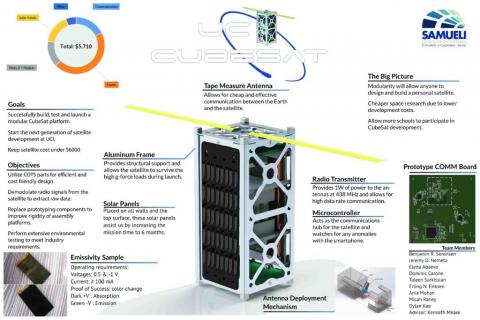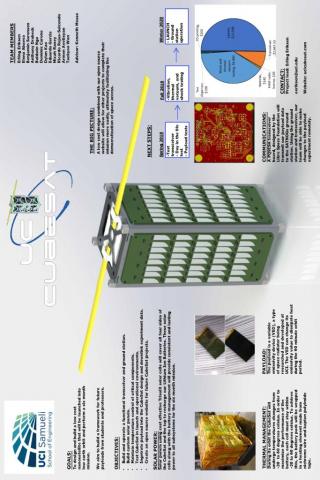Modular CubeSat
Background
Space has been inaccessible for most developers due to the high upfront cost of development. Traditional satellites can cost hundreds of millions of dollars to design and manufacture, and cost almost as much to launch into space. Launching in the past has been extremely expensive due to the nature of the size these satellites needed to be to perform their intended mission.
CubeSat development has become possible because of two main factors. One, technology has gotten cheaper in terms of computing power. Two, relevant technologies have gotten smaller. These two points are essential for space development to be accessible to more than governments and corporate giants. Because of this, Cal Poly San Luis Obispo created the CubeSat program, a method of designing nanosatellites powered by modern processors. Currently a 2-unit CubeSat kit costs ~$40,000, with a typical launch cost of ~$40,000; it costs ~$80,000 to build and put a CubeSat in orbit. This is still inaccessible for most student teams.
Goal and Objectives
Our goal is to create a modular satellite that costs less than $10,000. Other student teams will be able to use our design for their own missions. The design is meant to act as a base that other teams can modify for their own uses. Many other open source CubeSat projects provide kits to purchase but do not provide the information on how to create a CubeSat without a kit. CubeSat kits can be expensive which limits access to space for many student projects. Our project aims to create a CubeSat design process that can be replicated with minimal parts from kits. Our CubeSat design and our design process will all be open source and contained on our website.
Our CubeSat:
Our current design is a 2 unit CubeSat that will be launched in 2020 into a 310 km polar orbit. We have one payload as our starting point, the Variable Emissivity Device (VED). This device is a type of space radiator being research by Professor Khalid Rafique which can change its emissivity value to help dissipate heat while in orbit. During the six-month mission, our CubeSat will collect temperature data from the payload as well as corresponding GPS coordinates and UTC timestamps. In addition to the payload, the CubeSat will also contain a transceiver designed and built by the Libre Space Foundation, a GPS tracker, a lithium-ion battery pack with a heating element, solar panels covering five sides, a dipole antenna, an Arduino, temperatures sensors, and an antenna deployment mechanism.
Our objectives this year are as follows:
Fall quarter objectives
- Communication
- Send data stream using test transceiver.
- Solar Panels
- Tested solar cells to make sure they were outputting the correct voltage.
- Emissivity Sample
- Created a control circuit with a temperature input.
- Emissivity sample setting to the correct value with input.
- Created a control circuit with a temperature input.
Winter quarter objectives
- Communication
- Complete payload requirements to determine optimal downlink frequency and modulation scheme.
- Finish construction of SATNOGS ground station and control motion with Raspberry Pi.
- Order transceiver.
- Solar Panels
- Complete fabrication of solar panel array.
- Heating Element
- Complete construction of heating element.
- Systems:
- Complete CAD design of the CubeSat
Spring quarter objectives
- Communications
- Transmit data gathered by the emissivity sample.
- Solar Panels
- Charge batteries with solar panels.
- Finish design of battery management system.
- Payloads
- Alter emissivity value remotely using the transceiver.
- Systems:
- Complete circuit designs for all subsystems.
- Determine the attitude control method.
2019 - 2020:
- Complete all required testing
- Thermal vacuum testing
- Acoustic testing
- Vibration testing
- Shock testing
- Day In The Life test
Contacts
Faculty Advisor(s):
Professor Mease (kmease@uci.edu)
Student Contact(s):
Team lead: Erling Eriksen (eeriksen@uci.edu)



